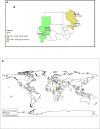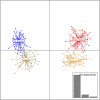Population Genetic Analysis of Aedes aegypti Mosquitoes From Sudan Revealed Recent Independent Colonization Events by the Two Subspecies
- PMID: 35251133
- PMCID: PMC8889412
- DOI: 10.3389/fgene.2022.825652
Population Genetic Analysis of Aedes aegypti Mosquitoes From Sudan Revealed Recent Independent Colonization Events by the Two Subspecies
Abstract
Increases in arbovirus outbreaks in Sudan are vectored by Aedes aegypti, raising the medical importance of this mosquito. We genotyped 12 microsatellite loci in four populations of Ae. aegypti from Sudan, two from the East and two from the West, and analyzed them together with a previously published database of 31 worldwide populations to infer population structure and investigate the demographic history of this species in Sudan. Our results revealed the presence of two genetically distinct subspecies of Ae. aegypti in Sudan. These are Ae. aegypti aegypti in Eastern Sudan and Ae. aegypti formosus in Western Sudan. Clustering analysis showed that mosquitoes from East Sudan are genetically homogeneous, while we found population substructure in West Sudan. In the global context our results indicate that Eastern Sudan populations are genetically closer to Asian and American populations, while Western Sudan populations are related to East and West African populations. Approximate Bayesian Computation Analysis supports a scenario in which Ae. aegypti entered Sudan in at least two independent occasions nearly 70-80 years ago. This study provides a baseline database that can be used to determine the likely origin of new introductions for this invasive species into Sudan. The presence of the two subspecies in the country should be consider when designing interventions, since they display different behaviors regarding epidemiologically relevant parameters, such as blood feeding preferences and ability to transmit disease.
Keywords: Aedes aegypti; Sudan; genetic diversity; microsatellites; population genetics.
Copyright © 2022 Elnour, Gloria-Soria, Azrag, Alkhaibari, Powell and Salim.
Conflict of interest statement
The authors declare that the research was conducted in the absence of any commercial or financial relationships that could be construed as a potential conflict of interest.
Figures






References
LinkOut - more resources
Full Text Sources

